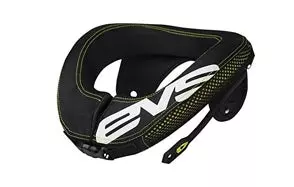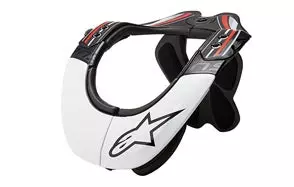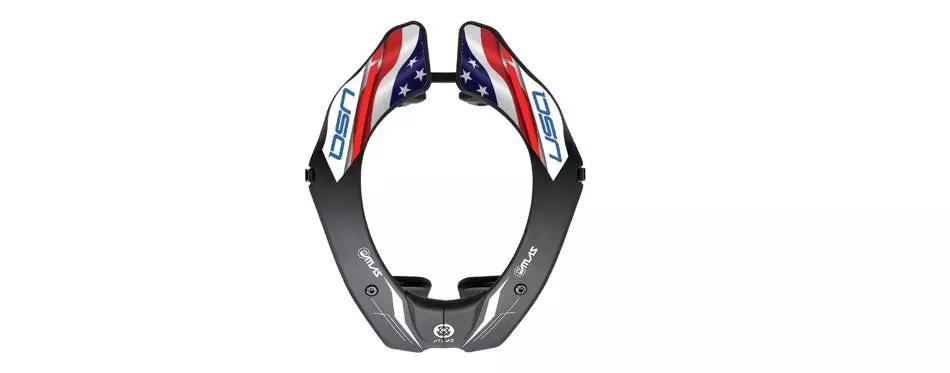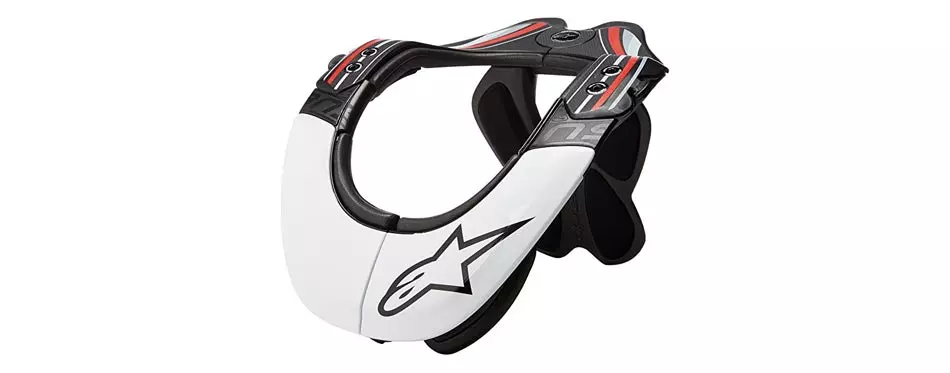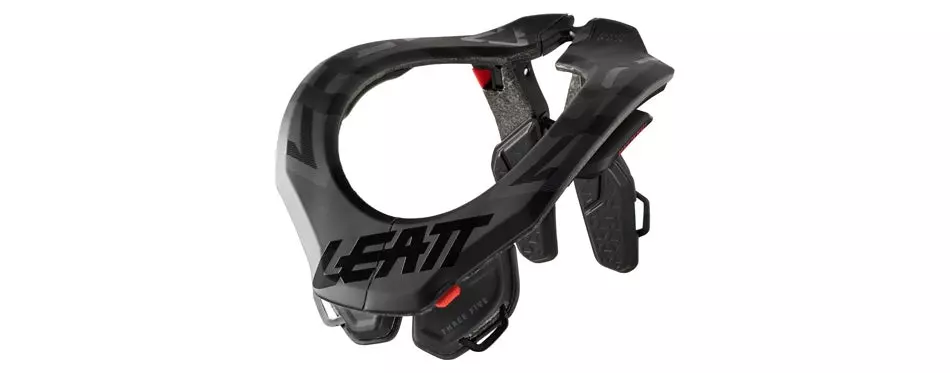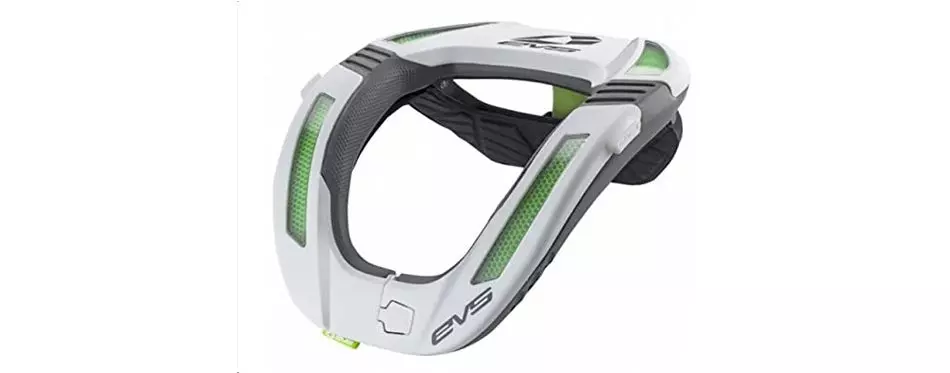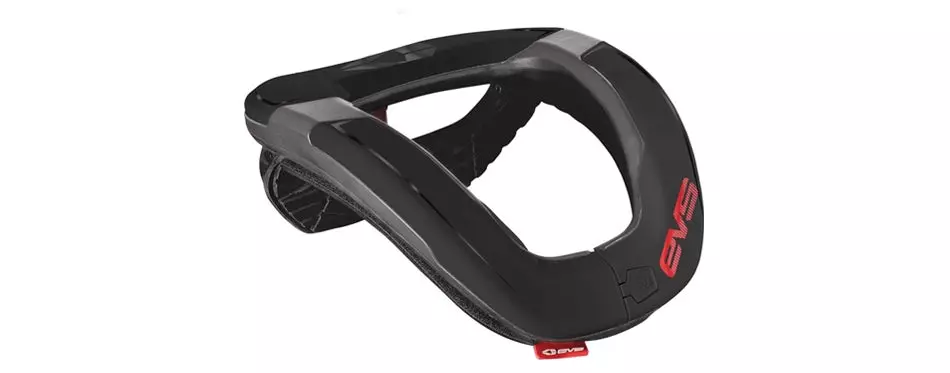If you like to throw it down off-road, you need protective equipment that will have your back. That’s exactly what motocross neck braces do. They work to either absorb or deflect the forces exerted on the head and neck to stronger parts of the body. By limiting head movement, the neck experiences less deflection, hyperflexion, and hyperextension.
We put together a list and buyer’s guide for the six best motocross neck braces. We take you through the best products, why you need one, and other details about these possibly life-saving devices.
The Best Motocross Neck Braces
The Atlas Air is our choice for the Best Motocross Neck brace. The Atlas is feature-rich as well as lightweight and low maintenance. Atlas states that this neck brace provides far more body contact than its competitors yet is very comfortable.
We appreciate how incredibly light the Atlas is, due in part to its polymer construction. Also, the split-flex technology allows the shoulders to move independently from each other to create a comfortable fit that keeps the brace where it needs to be under rough use. Factor in its cool designs and this motocross neck brace is a winner.
- Polymer construction
- Split-flex technology
- Lightweight materials
- Height adjustable
- Brand Atlas
- Model Air
- Weight 1.3 pounds
Weight makes it comfortable for all-day use
Increased body contact provides more protection
Easy to put on and take off
Sizing is a little difficult to nail down
May not be compatible with your chest protector
A little pricey
If you’re looking for an inexpensive collar to provide some protection when you’re out on the trail, the EVS Sport is a great option. At this price point, this foam collar has enough features to make sense for an array of riders.
The EVS Sports R3 Race Collar is seriously lightweight. You can wear this brace on the trail all day and forget you even have it on. Also, the price is a major draw because it’s accessible on any budget. It also has a removable shell that makes it simple to break down and wash.
- Removable shell
- Lightweight foam construction
- Easy on and off
- Compatible with most chest protector
- Brand EVS Sports
- Model 112053-0109
- Weight 11.2 ounces
So light you forget you’re wearing it
Price point is accessible on any budget
Comes with hardware to attach to a chest protector
Lower-end technology
Buckle feels cheap and unreliable
No adjustability
Our Premium Pick is the BNS PRO from Alpinestars. With a long tradition of two-wheel racing, it only makes sense that Alpinestars would offer such an impressive motocross neck brace. It’s perfect for riding dirt bikes, ATVs, or for any other type of off-road use.
As far as what we like, the BNS PRO has some great features. First, it’s very adjustable, more so than other offerings at any price point. Also, Alpinestars’ pivot key system makes breaking this brace down flat and packing it away simple. BNS stands for Bionic-Neck Support, which works by redirecting forces exerted on the neck and collarbone during a crash.
- BNS tech for extra protection
- Pivot-key system
- Quick-release closure
- Adaptable and interchangeable padding
- Brand Alpinestars
- Model 482-60
- Weight 1 pound
Easy to put on and take off
Packs away easily due to pivot-key
Highly adjustable
Heavier than other braces
May take a while to achieve a perfect fit
As expensive as some full-protection kits
If you’re looking for a neck brace from a leader in the field, you will definitely come upon a Leatt neck brace. The DBX 3.5 is a good, middle-of-the-road offering that shouldn’t drain your bank account but will still protect your neck.
There’s a lot to like about the DBX 3.5. The construction is rigid yet will flex with your body while you’re working the bike off-road. There is a lot of adjustability as well, so you can get a proper, safe fit. The pads won’t absorb any sweat or dirt.
- Rigid chassis construction
- Flexible shoulder pads
- Thoracic strut has a split design
- Rear strut folds flat for packing
- Brand Leatt
- Model 1018100202
- Weight 1 pound
Design stays in constant contact with the rider
More adjustment than other neck protectors
Contact points won’t absorb dirt and sweat
May sit a bit high despite adjustment
Sizing charts can be misleading
Closure system can be difficult to latch
The EVS Sports R4K Race Collar is built with some of today’s newest technology. The Koroyd system inside the brace consists of 95-percent air, making this brace lightweight yet still strong enough to protect you.
The R4K does a great job of staying in place while you’re off-road. It’s also light enough that you can forget you have it on. We also like the two-stage closure that combines a velcro strap and a mechanical latch for extra security.
- Koroyd technology
- Adjustable foam padding
- Adjustable thoracic strut
- Two-stage latch system
- Brand EVS Sports
- Model R4K-W-A
- Weight 1.3 pounds
Stays in place well when riding
Lightweight feel
Latch is secure but easy to manipulate
Main construction material is foam
May be uncomfortable for some riders
Included straps can be confusing
Similar to the R4K, the EVS Sports R4 Race Collar is a foam design, this time with a hard molded upper surface. This brace is designed to absorb forces and redistribute them through the shoulders and core.
The great benefit of this collar is the increased range of motion over other braces. Also, when the liner gets dirty and sweaty, it can be easily removed and thrown in a washing machine. Just like the R4K, the latch system is simple to use so putting it on and taking it off is easy.
- Hard molded exterior surface
- Low-profile design
- Two-stage latch system
- Adjustable thoracic strut
- Brand EVS Sports
- Model B01D4W0PX2
- Weight 1.8 pounds
Better range of motion than some other braces
Liner is removable for easy cleaning
Latch is simple to manipulate
Heavier than other braces
Much of the brace is constructed of foam
May not help with the issue of neck fatigue
Best Motocross Neck Braces Buying Guide & FAQs
Motocross neck braces have become a popular accessory for casual riders, free-riders, and racers in recent years. They’re a relatively new piece of equipment, however, as they were first developed in the early 2000s. Since then, several companies have developed and produced their own models, making them easy to find and compare.
Not all motocross neck braces are the same. There are special materials, styles, fitments, and safety features that may be unique to one brace versus another. In this guide, we explain how these braces work, what they come with, how to use them, and what to look out for when you’re shopping for one.
Do You Need a Motocross Neck Brace?
A motocross neck brace serves several functions. Its primary function is to keep the rider’s head in place in the event of a bad crash. During a crash, the theory is that the helmet will make contact with the brace, and the brace will transfer the forces to the shoulders, back, and chest area. These areas are far better equipped to absorb a heavy blow than the neck. This can protect the neck and spine from serious injury.
Another added benefit to motocross neck braces is that they can act as a frame on a rider’s shoulders, preventing hard cornering from straining the neck. When a rider is sending it into a tight hairpin turn, there are a lot of g-forces pushing the rider’s body outward. After a long day of riding or racing, that can lead to neck discomfort and fatigue. A motocross neck brace can help prevent that.
Another benefit to motocross neck braces is the confidence boost they can provide to riders to push themselves a little harder and get a little better. While motocross neck braces don’t make you a superhero, they can help you feel a little safer and give you the nudge you need to try something new.
- Neck braces can help protect the neck and spine from serious injury.
- You may experience less neck fatigue while wearing a neck brace.
- Braces can provide a boost in confidence to push yourself a little harder.
Types of Motocross Neck Braces
There are a few different types of neck braces on the market for motocross riders, and you should be aware of what they are and how they work. We explain the differences here. It’s your job to figure out which one is the best for your personal needs and riding style.
- Stand-Alone Neck Braces
Stand-alone neck braces are exactly like they sound. They’re a solo unit that you can wear by itself to protect your neck when you’re shredding a trail. These are often the least expensive, lightest, and most comfortable option to wear on a regular basis.
Stand-alone braces have some benefits and drawbacks. Most are light enough that you won’t even notice them on your neck. On the other hand, some are so light that they move around too much, making it uncomfortable to wear by itself.
That being said, stand-alone braces often come with straps. Lots of straps, actually. Underarm straps, chest straps, and straps that connect them to chest protectors. If you find your brace is moving too much, try utilizing some of the straps to hold it in place.
- Integrated Neck Brace
It’s recommended that you use a neck brace in conjunction with a chest protector. These are additional pieces of gear that protect the rider’s chest in a crash or from the roost from other riders. Integrated neck braces are built into certain models of chest protectors.
There are benefits to having a brace integrated into your chest protector. You only have to remember one piece of gear, and it does a great job of deflecting forces across the body to the stronger zones. Another benefit is that integrated braces won’t move on you in a crash.
However, they can be difficult to take on and off, and if your neck brace is uncomfortable, you can’t just upgrade to another unit. You’ll have to swap out the entire protector for another model. This can be an expensive way to customize your neck protection.
- Foam Braces
Foam neck braces serve the same purpose. They’re meant to protect your neck from a major deflection, but they accomplish it in a different fashion. Foam braces are meant to absorb the impact in a crash and dissipate it through the foam cells.
The great benefit with foam braces is that they’re simple and inexpensive to construct. They don’t require complicated attachment systems or features. As a result, manufacturers are able to pass the cost savings on and make inexpensive foam neck braces available to anyone.
Also, they do a decent job of absorbing forces for children who ride at lower speeds, and they’re lighter and easy to clean.
Features to Look for in Motocross Neck Braces
As in all things motocross, the newest gadgets and technologies reign supreme. This translates directly to neck braces and their features. Some motocross neck braces are full of bells and whistles, while others are bare bones and basic. Here we list the major features you should pay attention to when choosing your next motocross neck brace.
- Adjustability
One of the most important features you should look for in a motocross neck brace is a decent level of adjustability. There are several ways that companies can provide adjustability, but having the ability to tune your brace to your needs is important to ensure that you’ll wear it.
Each adjustable brace has a few ways of providing a custom fit. Some adjust from the thoracic strut in the rear of the brace. It can lift or lower the collar to fit your neck. Other braces adjust with removable shoulder pads that lift the unit up or lower it down. Finally, there may be some adjustment in the chest and back pads, which help to keep the brace where it needs to be.
- Closure System
This may sound like it’s not a big deal, but how easy a motocross neck brace is to put on and take off can be a huge factor in how often you’ll wear it. The easier it is, the more inclined you’ll be to let it tag along with you.
If there’s one thing dirt bikers love, it’s getting dirty and muddy. At the end of a long day, you want that filthy neck brace to come right off without it getting you even dirtier. If you can unfasten your brace and take it off with a pair of gloved hands, you’ll be a much happier rider.
- Weight
Your motocross neck brace’s weight can also be a primary reason that you’ll either wear it or leave it in the bag where it doesn’t help you. A heavy brace may irritate you or cause you to get tired over a long ride.
There are many ways for a manufacturer to reduce the weight in their braces, so make sure this is a feature that you look out for. Some companies use new, state-of-the-art technology like Koroyd to keep things light without compromising on safety. Others use foam padding in place of heavier materials. Choose the weight-savings method that you’re comfortable with and that will work for your riding style.
Tips for Buying and Using Motocross Neck Braces
We have some tips to help you figure out which one is best for you. To start with, bring your motocross helmet with you when you’re shopping. There’s a great benefit to knowing how your neck brace will work with your helmet before you head out to the trail. If you’ve got a shorter neck, you may find that you have no mobility at all when you’re wearing certain braces. Conversely, a longer neck may have too much mobility.
Also, make sure that the brace you’re purchasing is compatible with a chest protector if you wear one when you ride. All the braces on our list claim they are compatible with chest protectors, but your particular brace and chest protector may not work well enough together for your needs.
If you’re finding that your neck brace is the right fit but it still bounces around a little too much for your taste and comfort, try adding or changing the straps. You should be able to create enough tension to keep the brace in place without being tremendously uncomfortable.
- Bring your helmet shopping to ensure that it works with a particular neck brace.
- Verify that the neck brace you’re purchasing is compatible with your chest protector.
- Utilize the straps to get a custom fit.
Best Motocross Neck Braces FAQs
If you still have some questions about motocross neck braces, don’t worry because you’re not alone. There are so many questions on this topic that we’ve compiled a list of the most frequently asked ones. Chances are someone has asked your question already, so read ahead and see if we can answer it for you.
No. Larger neck braces might take up too much space and make it difficult to fit your chest protector on your body.
No. Some people still forgo a brace, believing that there hasn’t been enough definitive research to prove they offer much protection. However, if you’re racing, you may be required to wear one.
These neck braces are excellent for off-road recreation. Use them on a four-wheeler, side-by-side, or even while mountain biking to protect your neck from damage.
Our Top Pick
The Atlas Air neck brace is our Top Pick on our list of the 6 Best Motocross Neck Braces. Its lightweight design deserves some credit, but its increased body contact is the real all-star feature worth talking about. This brace will help keep you safe when a sticky situation comes up on the trail or track.


